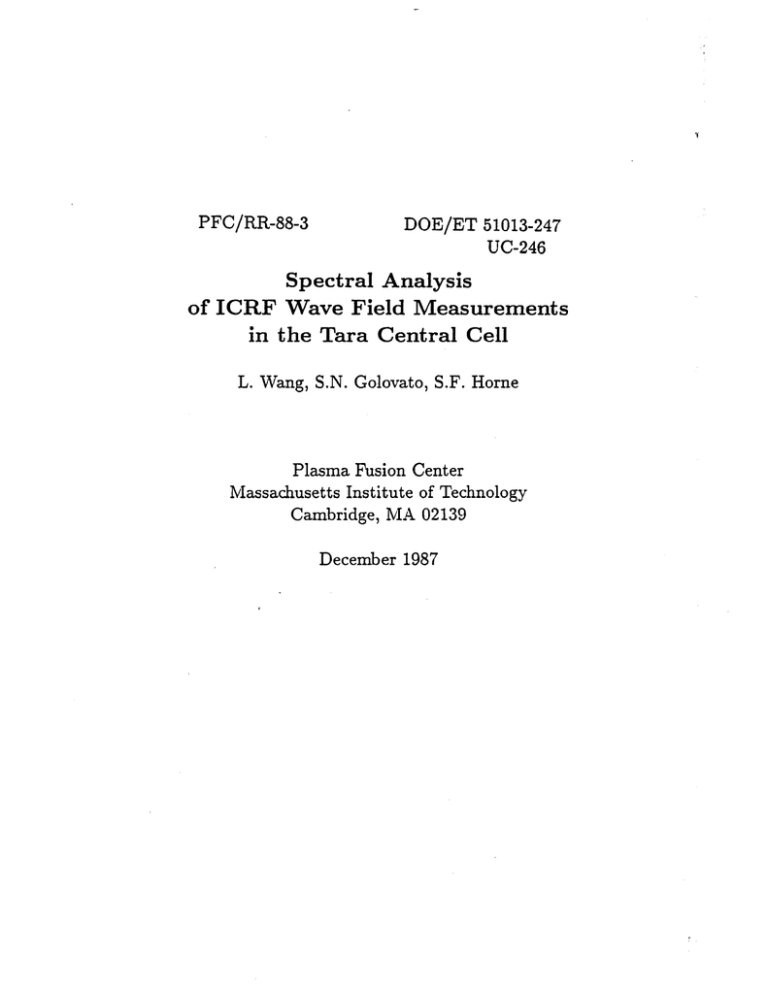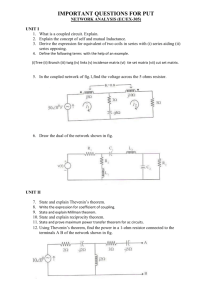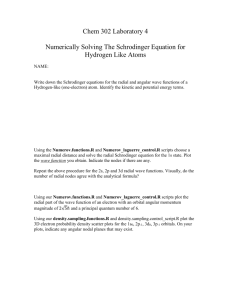Spectral Analysis of ICRF Wave Field Measurements PFC/RR-88-3
advertisement

PFC/RR-88-3
DOE/ET 51013-247
UC-246
Spectral Analysis
of ICRF Wave Field Measurements
in the Tara Central Cell
L. Wang, S.N. Golovato, S.F. Horne
Plasma Fusion Center
Massachusetts Institute of Technology
Cambridge, MA 02139
December 1987
Abstract
A simple spectral analysis technique has been developed to analyse the digital signals
from an array of magnetic probes for ICRF field measurements in the Tara Tandem
Mirror central cell. The wave dispersion relations of both the applied ICRF and the
Alfven Ion cyclotron Instability have been studied and the waves have been identified as
slow in cyclotron waves. The radial profiles of field amplitude and wave vectors were also
generated.
1
I.
Introduction
Plasma heating in the Ion Cycrotron Range of Frequences (ICRF) is used in the Tara
Tandem Mirror to build up and heat plasma" 2 in the central cell. To understand the
ICRF wave propagation and heating, one method is to measure by magnetic probes the
wave magnetic field amplitude distribution over space and the phase of the RF wave
to obtain the dispersion relation. In determining the wave amplitude and wave vector
from the digitized data of the oscillating RF fields, the most often used method is by
the Fourier transform of the cross correlation function.The technique is described in
many articles. 3 -
Rather than using Fast Fourier Fransformation (FFT)6 of the cross
correlation, an equivalent method has been developed which is simpler and faster to
process the large amount of data from experiments.
II.
Spectral Analysis
Assume the B field measured at time t is decomposed to its Fourier spectrum by
B(t) =
f
df B(f)e-2mi
=
f
dfB(f)e-2 rni t +
=
f
=
=
j0
f
2
0
df B(-f )e7i
t
t
+
f
f
df B*(f)e2 7rift + f
dfIB(f)j(e-i*()+
00
t
dfB(f)e- 2''
df B(f)edf B(f )e~
2
ift
2wift
0
2
ift + e af)-2-ft
dfJB(f)jcos(27rft - a(f)),
(1)
where we have used the fact that since B(t) is real
B*(f) = B(-f)
(2)
B(f) = IB(f)e"(f).
(3)
and also
2
If
IB(f)I
is significant only in Af and peaking at fo, the applied frequency, we then have
B(t) ~ cos(27rfot - a(fo))2
dfIB(f)I.
(4)
On the other hand assuming the wave we are measuring is of the form
B(z, t) = Bocos(27rfot - k(fo)z)
(5)
and comparing with (4) we get
a(fo) = k(fo)z + c,
(6)
dfIB(f)1.
(7)
where c is a constantand
B0 = 2
To get the dispersion relation k(f) the method used most often is the Fourier transformation of cross correlation, which has the following properties. If we have two time
dependent functions x(t) and h(t) the cross correlation function is defined as'
z(t) =
L
drxa(r)h(t + r).
(8)
We then have
Z(w) = H(w)X*(w),
(9)
where Z(w), H(w) and X(w) are Fourier transform of z(t), h(t) and x(t) respectively. In
our application, we can form a cross correlation function from the signals measured at
different positions for the same shot as
B 12 (t) =
J
drB1 (zi, r)B2(z2, t + r).
(10)
Since in general
B(z, t) =
J
dfB(z,
f)e-2wift
dfB(f)e(k(I)z-2f),
3
(11)
by (10) we get
B 1 2(f)
Since z1 -z
2
=
B12(f)
=
1B12(f)Ieia12(I)
=
B1(z, f)B*(z2,f)
=
JB1 (f)
IB2(f)| e(k())(zi-Z2)
(2
is known k(f) can now be obtained from the phase of the cross correlation
spectrum.
There are two ways to get B12(f). The first is to perform the integration (11) first
and then do the fast Fourier transform. The second is to fast Fourier transform B, (zi, t)
and B 2 (z 2 , t) first respectively and then multiply them to get the spectrum B12(f). The
second way is much faster than the first one by avoiding the time consuming integration.
Actually, we do not even have to get B12(f) by multiplication of B 1 (zi,
because of formula (6).
We can simply read off a 1 (fo) and
Ct
2 (fo)
f)
and B 2 (z 2 , f)
respectively and
substract them to get k(fo). We can determine the wave amplitude simultaneously from
the fluctuating spectrum by using the formula (7) via integration.
However, due to the other fluctuations in plasma such as instabilities and harmonic
genreration, the spectrum is not always clean. This leads to the difficulty in searching
for Af automatically by computer program. It also takes time to do the integration of
(7).
Another equivalent method exists thanks to the discreteness of the digital Fourier
analysis. Suppose we have a given sinusoidal wave
B(t) = Bosin(27rfot + a).
(13)
Its discrete Fourier transform has to be windowed. Suppose the window is square between
4
sampling time ti and t 2 . The Fourier spectrum is then
B(f) =
j
=
dtBosin(27rfot + at)erift
B0O f'~tt2 d(27ro+fnt+a) - _i(-21ro-f)t+a))
e
2i Jt
Boe=a
(e2w.i(f+fO)t2 - e27ri(+fo)tl)
2i27ri(f + fo)
Boe-ia (e21i-fO)t2 _ 27if-fo)tl)
2i27ri(f - fo)
(14)
B(f) peaks at f = fo where
B(fO) = Boe a(t2i 1 -t 2 )
(15)
from which we obtain B 0 as
BO=
21B(fo)|
It - t 2
21B(fo)l
(16)
At
One can also get this from (11) since for any spectrum Af ~ 1/At.
This says that for a good sinusoidal wave the amplitude is equal to the absolute value
of its Fourier spectrum peak divided by half of the sampling time interval. This technique
requires well seperated discrete modes in the Fourier spectrum in order to evaluate B(fo)
accurately.
A program which reads the experimental data, performs the fast Fourier transform,
and outputs the wave amplitudes and phases has been written in IDL.Z IDL is a software
system for the interactive analysis, reduction, and display of scientific data. The program
listing is shown here.
5
; This program inputs data from TARA data base and outputs the amplitude
; and the phase at the peak frequency.
CLOSE,1
FILE-'DENSITY.SCAN'
SHN-INTARR(100)
FOR M-1,27 DO BEGIN
SHN(M)-14883+M
ENDFOR
Tl-.0300
;SHOT NUMBERS
;SAMPLING TIME INTERVAL
T2-.030256
N1-8191
N2-N1+1
PI-ACOS(-1.)
;NUMBER OF DATA POINTS
P12-2.*PI
DLT-T2-T1
DT-DLT/FLOAT(N2)
;FREQUENCY SCALE MHZ
Q-1.E6
;32 MEGAHERTS DIGITIZER
FREQ-32./FLOAT(N1)*FINDGEN(N2)
SS-( T1/DLT)-FIX(T1/DLT)
HFF-(SS*FINDGEN(N2) )-FIX(SS*FINDGEN(N2))
F11-3.45
F12-3.50
S-( '1', '2','l3','4','5','6']
OPENW,1,FILE
FOR K-1,27 DO BEGIN
; READ IN DATA
SHOTN-FIX(SHN(K))
PRINTF,1, 'SHOT#-' ,SHOTN
FOR J-1,6 DO BEGIN
SIG-'CC BDOT R'+S(J-1)
DUMMY-SET SHOT(SHOTN)
Y-DATA(SIG)
T-DATA('CC BDOT Ri TM')
;IMSL FFT
- ~
HF1-FFTRC(Y)
;TAKES CARE OF PHASE
HF1-COMPLEX(COS(PI2*HFF),SIN(PI2*HFF))*HF1
AP-ABS(HF1)
PH-FLOAT(ATAN(HF1))
HF1-0
MX-MAX(AP(WHERE((FREQ GE Fli) AND (FREQ LE F12))))
AMP-2. *M/FLOAT (N2)
FS1-PH(WHERE(AP(WHERE(FREQ LE 6.)) EQ MX))
FM1-FREQ(WHERE(AP(WHERE(FREQ LE 6.)) EQ M))
OMEGAPEAK-FM1(0 )
PHASE-(PI-FS1(0))*180/PI
PRINTF,1,SIG,' AMP-',AMP, $
' PHASE-',PHASE
ENDFOR
ENDFOR
CLOSE,1
END
;SEARCH FOR PEAK
;GET THE PEAK AMPLITUDE
;GET THE PEAK PHASE
;OUTPUT
*
**
III.
Experimental Results
An array of magnetic probes has been used to measure the ICRF fields in the central
cell of the Tara Tandem Mirror. Each probe consists of three orthogonal six turn coils to
measure all three field components simultaneously. They are Faraday shielded, centertapped, and encased in insulator to ensure that signals are due solely to ICRF magnetic
fields. The probe frequency response 3 dB point is 14 MHz. The probes have been
calibrated in Gauss and the instrumental phase shifts have been taken into account. The
3.47 MHz ICRF is excited by a slot antena located on a bump of mirror ratio 1.7 at the
central cell midplane and propagates to a beach resonance where
W-+ w E eB
mc
(17)
on either side of the bump. The probes are located along the beach at 3 axial and 3
azimuthal positions.
Experiments were also done with and without a divertor at the central cell midplane.
The purpose of the divertor is to stablize the plasma. It creates a magnetic null at the
midplane near the plasma edge which may affect the wave propagation since there will
be a resonance in this region.
A typical specrtum of the azimuthal component of the RF magnetic field, Be, is
shown in Fig. 1. The observed fields are (1) applied ICRF at 3.47 MHz and (2) plasma
generated Alfven Ion Cycrotron (AIC) instability modes' along with harmonics and nonlinear combinations of these principal modes. The measured dispersion relations of the
ICRF and AIC waves are shown in Fig. 2 and 3 respectively. They both satisfy the slow
wave dispersion relation for infinite homogeneous cold plasma"
ki=
w:
a
C
-
(1 - (W/W.)2),2
(18)
where w, A (47rne2/m)1/2. Figure 4 shows the radial profiles of the ICRF amplitude, Be,
at three different azimuthal angles with and without magnetic divertor. The divertor has
6
little effect on the radial profiles of RF magnetic fields. The B field vanishes at plasma
edge and peaks at a radius of 10 to 15 cm. The radial profiles show some azimuthal
dependence.
The left and right circularly polarized wave profiles are shown in Fig. 5. There is no
strong polarization effect. In Fig. 6 we can see that B,. components are flat and Be peaks
at r ~ 15cm. The central cell divertor has little effect on them.
We have also investigated the azimuthal wave number ke(r) which is defined by
B
-
(19)
ei(ke(r)O-kj(r)z).
Figure 7 shows he is similar with and without divertor and has radial structure with
mixed m mode. That is, it is not a simple m = +1 or m = -1
mode.
The radial profiles of the axial wave number kh defined in (19) are shown in fig. 8.
k11 increases as w approaches w.
The slow wave is seen in the plasma core and the fast
wave (small kgj) only at extreme edge (beyond limiter).
Fig. 9 displays the B9 field amplitudes vs w/wd. Be increases as w/wd -+ 1 as expected
from Eq. (19).
Finally the scaling of k 11with gas fueling rate is shown in Fig. 10. k
||
the fueling is increased in agreement with Eq. (18) where wi ~ V/ so k11 ~
increases as
r.
Acknowledgement
The authors would like to thank Richard C. Myer, and John Machuzak for helpful
disscusions.
7
References
'R. S. Post, et al, Plasma Physics and Controlled Thermolnuclear Research Conference
Proceedings, Kyoto, 13-20 November 1986, pp. 251-262, vol 2.
N. Golovato, et al, AIP Conference Proceedings 159, Applications of Radio-frequency
2.
Power to Plasmas, Seventh Topical Coference, Kissimmee,F1 1987, Editors , S. Bernabi, et al, pp 254-257.
'E. B. Hooper,Jr., Plasma Physics 13, 1 (1971).
4
M.
Bernard, et al, Plasma Physics and Controlled ThermalnuclearResearch Conference
Proceedings, Novosibirsk, 1-7 August 1968, pp. 715-733, vol 1.
'D. E. Smith, et al, IEEE Transactions on Plasma Science, vol. PS-2 Dec 1974.
'E. 0. Brigham, The Fast Fourier Transform, N.J. Prentice-Hall, 1974.
7 Research
Systems,Inc. 2012 Albion Street Denver, C080207, Introduction to IDL, Feb
1,1987.
sT. H. Stix, The Theory of the pLsma waves, McGraw-hill, 1962, p. 35.
9 G.
R. Smith, Phys. Fluids 27, 1499 (1984).
8
Figures
FIG. 1. A typical spectrum of the azimuthal component of the RF magnetic field, Be.
FIG. 2. The dispersion relation of the applied ICRF wave. The solid line is the dispersion
relation of the slow Alfven wave for the infinite homogeneous cold plasma. i.e.
1
,,
k
kii - We C (1 - (w/wd)2)'
_
2
FIG. 3. The dispersion relation of the plasma generated AIC mode. The solid line represents the same formula as in fig. 2.
FIG. 4. The radial profiles of the amplitude of Be at three different azimuthal angles.
FIG. 5. The radial profiles of the amplitude of left circular B+ and right circular B_
polarized wave at two different w/wd positions.
FIG. 6. The radial profiles of the amplitude of radial component B,. and azimuthal component Be waves with and without divertor.
FIG. 7. The radial profiles of azimuthal wave number at two different angles with and
without divertor.
FIG. 8. The radial profiles of axial wave numbers for Be at two w/wd positions with and
without divertor.
FIG. 9. The Be fields vs w/wd.
FIG. 10. The scaling of axial wave number with density.
9
CC.BDOT_R2
Phose
Co
ro CO
Ampi tude
(.
o
I~~J
-,
<
-
-
-
I*'J
-
-ni
0
C
I
-
0
rF1-
M~
U,
(I)
CD
c0
1c
3r
-1,
P-
C.
U
--
r-7r
.K co
c-
-
rn
co
w
I lit
C
I llif l
I
-fil
C
C)
C
C=)
C
C
0
Constance B Mirror Exper.ment
M.1
F
.
usion Center
8-MAR-aS 22t42
Figure 1
NERUS:tWANG
(iGENLfPOr
r=13.5cm, n~lxl1 2 CM-3
0.2
0.15
0.1
0.05
. .......
0
010
r=7.5cm, n=2x10 1 2cm-3
0.2
0.15
0.1
0.05
0
0.65
(I
'
0.7
0.75
0.8
Figure 2
0.85
0.9
r=13.5cm, n=xl1012cm~3
0.1
0.08
7
E
U
N
0.06
0.04
0.02
0
r=7.5cm, n=lxl012cm~3
0.1
I-
II
0.08
E
U
N
0.06
0.04
~
I-I
0.02
0
0. 5
0.55
0.6
0.65
Figure 3
0.7
0.75
Radial Scan w/o Divertor
Radial Scan with Divertor
8
I
I
I
6
4,
4
I
4,
4,
2
4,
8
I
I
I
I~
0
I
I
I
-*
6
,$$
4,
CO
4
$
$
4,
2
4,
4,
0-
0
-,
-
12
4,
10
-
$
$-
8
6
(0
II
$
4
4,
4,
2
0
0
5
4,
4,
15
10
Radlus(cm)
20
25
0
Figure 4
5
15
10
Radius(cm)
20
25
ci/cA.=0.75
6
I
I
I
I
5
-
4,
4,
4
CD
I
4,
3
2
~4,4,
$
1
0
6
I
*4,
I
I
I
I
-I
4,
*
*~
$
I
I
I
5
4
3
$
$
4'
-
* **
2
4,
4,
*
4,
~4,
1
I
0
0
5
I
15
10
Radius(cm)
0
I
20
25
0
Figure 5
I
5
I
15
10
Radius(cm)
I
20
25
Radial Scan with Divertor
8
Radial Scan w/o Divertor
6
C,
4
2
0
8
6
I
C,
I
I
A
I
I
I
5
10
15
I
4
2
0
0
5
15
10
Radius(cm)
26
.25
0
Radius(cm)
Figure 6
20
25
Radial Scan with Divertor
300
I
.
I
I
Radial Scan w/o Divertor
I
I
I
I
I
I
I
250
'c
C*4
4,4
200
$
150
100
50
I
0
300
250
Co
200
150
e
100
4,
50
I
0
0
5
10
15
Radius(cm)
20
25
0
Figure 7
5
4,
15
10
Radius(cm)
20
25
0 ct=o.75
0.2
0.15
E
U
I
w/w,0=.75 to .87
to .87
$
0.1
N
0.05
0
w/o divertor
4 ct=.
0.2
65
to .75
c/c.,=.75 to .87
0.15
0
E
U
0.1
<>
I
I
N
0.05
$0
0
0
5
10
15
Radius(cm)
20
25
0
Figure 8
0
D
10
Radius(cm)
JU
20
I
25
Radrus=7.5 (cm)
I
1
E
0-
Radius= 13.5 (cm)
I
I
I-T
4,
4,
4,
~,
4
4,
L0
4
I
I
I
-7-
4,
4,
coin
4,
4,
4,
N
4,
4,
4,
4,
C,
I
I
r
I
I
I
I
I
4,
4,
4,
4,
4,
80
I
I
I
85
90
95
I
100
105
110
80
8,..(%)
Figure 9
85
90
100
95
BMO(%.)
105
110
=0.66 to 0.76
co/c
0.2
co/co~1 =O.76 to 0.90
I
I
I
I-
0.15
E
0
E
0.1
4
4,
0.05
4
4'
I
I
0
I
I
0.2
U
U,
0.15
4,-
4'
0.1
4,
$
E
0.05
0
0
10
20
30
40
0
Fueling (T-L/S)
Figure 10
10
20
30
Fueling (T-L/S)
40




